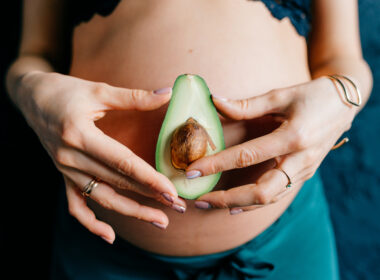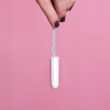Have you seen people online mention menstrual cups, period underwear, or cloth pads? They’ve been getting some good press lately. Maybe you’ve been intrigued by the idea of never having to buy tampons again (especially given the recent headlines concerning heavy metals found in tampons), or by the promise of a “greener,” more eco-friendly period… but the idea of doing all that research and learning how to use something new just feels overwhelming, so you haven’t tried any of it, yet.
Life with reusable menstrual products can be easy, comfortable, and healthy, but making the switch can seem daunting. I’m a decade-long menstrual cup and cloth pad-user, here to clear everything up for you. I’ve got the information you need and answers to all your questions. Here’s the ultimate step-by-step guide to making the switch to a greener period.
If you’re currently a tampon user, switch to a menstrual cup or disc
Menstrual cups are great. They can typically hold more than a tampon, and you can wear them for up to 12 hours. You can swim with them. You can even use them early (i.e., before you’ve seen any bleeding) in anticipation of your coming period, and there’s nothing extra to carry around with you! The only downside is the learning curve, so here’s what you need to know.
There are two basic styles of product to be aware of. Cups are shaped like a little silicone goblet. They sit up around the cervix and are held in place by a slight suction. Discs are flatter and made of either plastic or silicone. They tuck up behind the pubic bone to stay in place. Many discs advertise they can be used for mess-free period sex as well, which isn’t recommended with a cup. Both shouldn’t feel like anything at all if properly seated within the vagina, and both work by collecting period blood for later disposal into the toilet.
There are dozens of menstrual cup and disc brands and versions available on the market. Some of them have little gimmicks and features, but most work pretty much the same. The good news is, it’s easy to get started. I recommend https://putacupinit.com for their handy questionnaire to help you pick a good menstrual cup or disc for you. There are a few options available in stores, as well as any number of places online.
How to use a menstrual cup or disc
Once your chosen cup arrives, start by sanitizing it. (Instructions below.) Then, if you’re excited, you can test it out right away to get a feel for insertion and removal (which can help you feel more prepared and confident before the big day). Since menstrual cups collect rather than absorb, they’re non-drying, and comfortable and safe to try on even before your bleeding starts.
Inserting a menstrual cup or disc
Basically, you’ll have to fold your menstrual cup or disc into a narrow shape for insertion, then let it pop back to its original shape once it’s in place. There are multiple folds you can find tutorials for online. I’d recommend something simple like the “C fold” or “7 fold” as a starting point. (See https://putacupinit.com/menstrual-cup-folds/ for more info!) Once in place, I like to do a couple of squats to settle my cup into its most comfortable position.
Removing a menstrual cup or disc
To remove your cup, you’ll have to reach in with two fingers and squeeze the base of the cup to release the suction before pulling. Don’t just grab and yank! Remember, cups are held in place by a slight suction around your cervix. Discs are removed with a crooked finger. With a little practice, you can tilt it so that nothing spills onto your hands. After a quick rinse between uses, you’re ready to reinsert and continue about your day!
How to change your menstrual cup or disc when you’re not at home
When I’m out of the house and need to change my cup (i.e., dump out the collected blood and reinsert the cup), I usually give the cup a quick wipe with toilet paper before reinserting it. Baby wipes or a water bottle could be a good option for further cleaning if you’re more prepared than I am. I do have to warn you that you might end up with a little blood on your hands. Nothing that soap and water won’t fix!
I would recommend wearing a cloth pantyliner or period underwear for backup for your first cycle or two, until you can get the hang of it and troubleshoot any leaks. If you do experience leaks, make sure the cup is fully open and positioned around your cervix. If you experience leaks even with proper positioning, you might just have to change your cup sooner.
By the way, you can use the bathroom for number 1 or number 2 just fine with your cup in place. However, you might find you either need to remove and/or reposition it after a number 2. All those “bearing down” muscles are tied together after all!
Keep your menstrual cup or disc sanitary between periods
Finally, you’ve reached the end of your period and you’re ready to store your cup away until next month. It’s a good idea to quickly sanitize your cup once a cycle. Give it a good rinse, then boil it in a pot of water for a couple of minutes (pop it inside a metal whisk to keep it from burning) or you can do like I do, and sterilize it in the microwave! Multiple cup manufacturers also sell silicone cup sterilizers to make it as easy as possible to keep things clean. (I place a plate under my sterilizer in case anything spills over)
After your cup is clean and dry, simply store it in the little breathable cloth pouch it came with until next month!
If you’re a pad user, switch to cloth pads or period underwear
I’ll be honest: I love my cloth pad stash. They’re so much more comfortable than the scratchy, sticky, stinky disposable pads I used to use. You save money not having to buy new products every month, and of course you’re not sending piles of plastic to the landfill. There is a tradeoff, though. Cloth pads are typically bulkier than their disposable alternatives, and of course, you have to wash them. Here’s why I still think making the switch is worth it.
Let’s go shopping: where to buy cloth pads
There are plenty of places to find cloth pads online these days. You can get cheap starter sets on Amazon, or find many talented makers on Etsy who’ll make you custom pads with more interesting designs and patterns. I actually made most of my own with the fantastic beginner-friendly tutorials by Amy Nix on YouTube.
Cloth pads come in different lengths as well as different absorbencies. Trial and error can show you what you like best, but start by measuring your favorite disposable pad and match that length. Somewhere around 10 inches works for me during the day, and longer for overnight.
How many pads do you need? Well, how many do you typically use in a day? I’d start with two days’ worth, so you can wash half while you wear the other half. To keep it simple, I’d suggest something like 4 liners, 6 moderate to heavy pads, and 2 overnight pads. Later on, when you have an idea what you like, you can build your stash from there.
But don’t get hung up on making sure you have “enough” before you get started. Switching to reusable products doesn’t have to be all or nothing: every time you use a cloth pad, you’re not using a disposable one. You can switch back and forth or just build your stash slowly over time.
How to use cloth pads
How do cloth pads work? Pretty much like a disposable pad with wings does, only instead of adhesive, you use snaps around the gusset of your panties to keep them in place. They’re much simpler to reposition than adhesive pads as a result, but I’ve never had trouble with them shifting around. If you have issues with your cloth pads shifting too much, look for a pad with flannel or fleece backing and a hidden waterproof layer.
Heading out of the house? You’ll probably want to take a spare pad or two along with you, and you’ll need somewhere to keep the used one to take back home. You’ll want a “wet bag” (an example is here), which is washable and lined with a water resistant polyurethane laminate (PUL) layer. You can also wrap a used pad in on itself and snap it shut for transport.
Are you worried your used period products will smell? Good news! You probably don’t have to be. Most cloth users find that their cloth pads smell way less than their disposable ones. Just store your used pads in a breathable hamper or “wet bag” until wash day.
Washing your cloth menstrual pads
Washing cloth pads is likely the biggest worry for the new user, but it does not have to be complicated. First, the dead easy way: throw it in the wash. That’s it. That’s really it. You can rinse them in the sink first, and/or wash them separately from your other clothes, but I’ll be honest with you: I’m lazy and all I do is toss my pads into the laundry hamper with my regular load. I do wash most of our clothes in cold water, which is definitely recommended for protein stains. But it all comes right out, and is ready to use again straight from the dryer.
There is a more complicated routine you can try if you’d like to treat and/or prevent stains in your cloth pads. First, soak your pads in Oxyclean, then pretreat any stains with a Fels Naptha bar. This isn’t too labor intensive and keeps your pads nice and pristine, but I still recommend the strategy of not caring about stains. It’s not like you’ll be showing them off, right?
Think about Thinx period underwear
Nowadays period underwear has gotten very popular, with 74,000 Google searches/month! I have to tell you I’ve never used any, but I can see the appeal. They look way more comfortable than wearing a pad–especially a disposable one.
Just know that period underwear typically has a smaller capacity than a cloth pad, so you might have to change more frequently on your heaviest days. Also consider what clothing you like to wear, and whether you have a place to change your period underwear during the day. For example, consider that it might be simpler to change a cloth pad in a public bathroom, which you can do without removing your pants all the way, which would of course be necessary to get period underwear off! That said, cloth pads and period underwear (and cups and discs) work great together, so feel free to mix and match!
A note about products for postpartum bleeding
After you have a baby, doctors will advise nothing inserted vaginally for 6 weeks. That means no sex, no tampons, and also no menstrual cups or discs. If you’re going the reusable/cloth route for managing your postpartum bleeding and discharge (also known as lochia, see our helpful primer on that, here!) you’ll want the longest, highest absorbency pads you can find. These will be marketed as overnights or postpartum cloth pads. I like minky fabrics (yes, the same minky used in children’s blankets!) for extra plush. I’ve even brought them to the hospital with me to start using the next day! I feel so much more like myself postpartum after a shower, in my own underwear and cloth pads instead of wearing the massive, crinkly hospital ones.
After a few weeks, you’ll probably find you don’t need such heavy protection anymore, and can graduate to cloth liners or period underwear until your bleeding stops.
Making the green switch for your period doesn’t have to be complicated or scary
I haven’t had to buy, insert, or throw away a tampon for the last decade. I’m more confident and informed about my body and my periods now than I ever was before, and it’s thanks to reusable menstrual products. I hope that I’ve been able to give you some peace of mind and encouragement if you’re looking to make the switch yourself. It’s totally doable and can be remarkably easy and hassle-free. Good luck on your journey!
Additional Reading:
How to “green” your period (and why you might want to)
Breastfeeding: The eco-friendly baby feeding option
Having “green sex” might be the best thing you can do for the environment












Menstrual cups and disks have recently been found to have high levels of PFAS. They didn’t seem to be a viable option